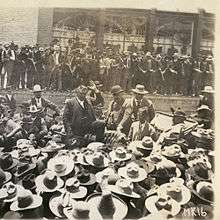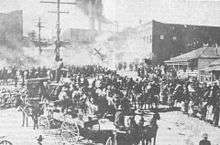Cananea strike
| Cananea Strike | |
|---|---|
 Striking workers in Cananea confront American possemen protecting the company store. | |
| Objective | Obtain better working conditions for Mexican employees at the Cananea mines. |
| Date | June 1, 1906 |
| Casualties | 23 killed 22 wounded |
The Cananea Strike, also known as the Cananea Riot,[1] or the Cananea Massacre,[2] took place in the Mexican mining town of Cananea, Sonora, in June 1906. Although the workers were forced to return to their positions with no demand being met, the action was a key event in the general unrest that emerged during the final years of the regime of President Porfirio Díaz and that prefigured the Mexican Revolution of 1910. In the incident twenty-three people died, on both sides, twenty-two were injured, and more than fifty were arrested.
Location
In 1906 Cananea was a company town with a population totaling 23,000. Of these 21,000 were Mexican and the remainder American. Order was kept by a private police force maintained by the Cananea Consolidated Copper Company. The only source of foodstuffs and other commodities was a company store, which reportedly sold its goods at high prices.[3]
Strike



By 1906, the Nogales-based Cananea Consolidated Copper Company had some 5,360 Mexican workers employed at its Cananea copper mines, earning three and a half pesos per day while the 2,200 American workers there were earning five pesos for the same job. Conditions in which the Mexican employees worked were deplorable. During the celebrations of Cinco de Mayo, the Mexican employees made public their complaints while the local authority applied martial law to avoid further conflicts.
On June 1, most of the Mexican miners went on strike. Led by Juan José Ríos, Manuel Macario Diéguez and Esteban Baca Calderón, their demands were the removal of one foreman named Luis, the pay of five pesos for eight hours' work, the employment quotas ensuring seventy-five percent of the jobs for Mexicans and twenty-five percent for foreigners, the deployment of responsible and respectful men to operate the cages and that all Mexican workers to be entitled to promotions, in accordance with their skills.
The company executives rejected all of the petitions and the workers decided to march and gather people from other towns in the municipality. The population supported the workers and the crowd numbered more than 3,000 people. While they were marching in front of the wood shop of the company, the American employees in charge of that department, the Metcalf brothers, threw water at them and then fired shots, killing three people. The angry mob detained the brothers and lynched them by setting them on fire. When they approached the government building of the municipal president they were received by a 275-man American posse led by Arizona Rangers. Other workers were killed while the strike leaders were sent to prison. Contemporary news reports in the New York Times on June 3, 1906 reported that on June 1, strikers destroyed a lumber mill and killed two brothers who were defending the mine. Eleven casualties were reported among the Mexican "rioters".
About half of the company police avoided involvement in the disturbance. Responding to a telegraphed plea from Colonel William Cornell Greene of the Greene Consolidated Copper Company, a posse of 275 volunteers from Bisbee, Douglas and Naco, Arizona, commanded by Captain Thomas H. Rynning of the Arizona Rangers, entered Mexico against the orders of Joseph Henry Kibbey, Governor of Arizona Territory. At the order of Rafael Izabal Governor of Sonora, forty Rurales (mounted police) were despatched from Hermosillo to reinforce a detachment under Colonel Emilio Kosterlitsky already present. Mexican Federal troops were also sent to Cananea.[4] Four troops of the 5th Cavalry en route from Fort Huachuca were held at Naco, Arizona, on the border on the orders of President William Howard Taft.
A tense confrontation between striking miners and approximately 200 Americans ensued. Many participants were armed and shots were exchanged. At Colonel Kosterlitsky's orders the American interventionists left the town by rail, to return across the border. Mexican Rurales and Federal soldiers then disarmed the strikers and made arrests.[5]
Aftermath
According to Colonel Green the "trouble was incited by a Socialistic organization that has been formed by malcontents opposed to the Díaz government." [6][7][8][9]Shortly before the strike, a political party called the Partido Liberal Mexicano (PLM) had been established with wide support. The PLM quickly became involved in aggressively pressing for industrial and rural reform. At both the French-controlled Rio Blanco textile factory and the American-owned Cananea Copper Company mine, PLM literature was subsequently to be found distributed through the workers' settlements. [10]
Although the government forces present had behaved with relative restraint, the entry of armed foreigners into national territory caused Mexican outrage against the Diaz administration. Diaz had sent orders to Governor Izabal not to accept any American involvement in restoring order in Cananea but the telegram had arrived after the trainload of Arizona Rangers and civilian supporters had crossed the border.[11]
The incident became linked with the Río Blanco strike of January 1907 as two symbols of the Porfirio Díaz administration's corruption, subservience to foreign interests and civil repression. They became "household words for hundreds of thousands of Mexicans".[12]
A corrido titled "Cananea jail" written in 1917 commemorates the incident.
The Cananea municipal jail, built in 1903 and located in downtown Cananea, is currently a museum Workers' Struggle Museum and also houses exhibitions of photographs and instruments used in mining.
The mine in Cananea currently continues to be worked for copper. After the original 1906 strike the Cananea mine has remained the scene of frequent labor disputes, with the most recent incident being a five-month miners strike that has lasted into January, 2008.[13]
References
- ↑ http://www.cosmeo.com/viewPicture.cfm?guidImageId=316D390A-2AEE-48B4-B73A-AEFAD9986B84&&nodeid=
- ↑ http://www.voiceseducation.org/category/tag/cananea-massacre
- ↑ Paul J. Vanderwood, page 144 "Disorder and Progress - Bandits, Police, and Mexican Development", ISBN 0-8420-2438-7
- ↑ Paul J. Vanderwood, page 144 "Disorder and Progress - Bandits, Police, and Mexican Development", ISBN 0-8420-2438-7
- ↑ Paul J. Vanderwood, page 144 "Disorder and Progress - Bandits, Police, and Mexican Development", ISBN 0-8420-2438-7
- ↑ "ARMED AMERICANS AT GREENE'S MINE; Rushed Into Mexico from Arizona Against Gov. Kibbey's Orders. TAFT HOLDS UP U.S. TROOPS Cavalry from Huachuca Stopped at the Frontier — Only Two Americans Killed in Riots" New York Times June 3, 1906, Greene Consolidated Copper Company, Cananea, Mexico
- ↑ New York Times report from Mexico City giving the viewpoint of the Mexican government, June 2, 1906]
- ↑ "WENT AGAINST ORDERS; Governor of Arizona Warned Capt. Rynning and Other Americans" New York Times, June 3, 1906
- ↑ "MEXICANS RESENT INVASION.; Charges Against Gov. Yzabel, Who Let in Arizona Rangers" New York Times October 12, 1906
- ↑ Michael C. Meyer and William H. Beezley, page 437 "The Oxford History of Mexico", ISBN 0-19-511228-8
- ↑ Paul J. Vanderwood, page 145 "Disorder and Progress - Bandits, Police, and Mexican Development", ISBN 0-8420-2438-7
- ↑ The Cambridge History of Latin America, by Leslie Bethell, Cambridge University Press, 1986, page 66
- ↑ "Miners call nationwide strike over Cananea" Guardian Unlimited January 14, 2008